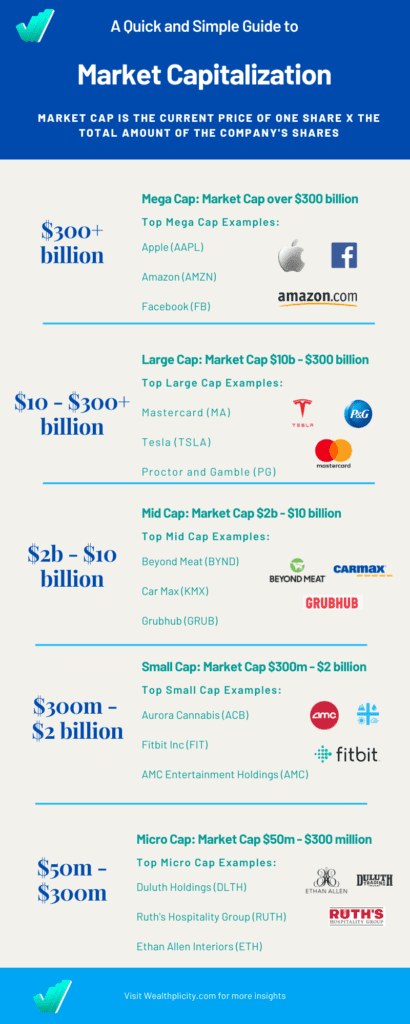For those of you just starting out on your path to financial independence , understanding the basics of investing is a crucial first step. Every financial avenue is connected in one way or another. So, for any expert who is investing in crypto currencies, swing trading or real estate investing, they all had to start somewhere, and that was usually with learning how to invest in stocks and equities.
What is a stock?
Stocks and equities (the two terms are interchangeable) are, quite literally, securities that a public company issues in order to raise money and expand their business. When you purchase a stock, you are now considered a shareholder of that company and part owner. Stocks are bought and sold on exchanges such as the New York Stock Exchange (NYSE) and their prices are determined by supply and demand as well as other factors.
Stocks by Market Cap
Market Capitalization or Market Cap is the total dollar market value of a company’s shares of stock. Essentially, Market Cap is calculated by multiplying the current price of one share total amount of the company’s outstanding shares.
If a company has 5 million shares selling for $50, that company would have a market cap of $250 million.
The Five Types of Market Cap:

Stock Market Sectors
Every single stock on the stock market is organized into categories called Sectors. They are then broken down further into industries. There a total of 11 sectors that classify all stocks based upon their product and economic traits. For example, some of the top stocks in the tech sector are Microsoft (MSFT), Facebook (FB) and Apple (Appl).
Investors use sectors for more than simple categorization of stocks. It is critical to understand how different sectors interact with each other. This is type of investing is considered a top-down style of investing where you start with a broad category such as sectors and then home in on a certain stock.
A great example is looking at the Energy Sector during the 2020 Pandemic. The demand of gas and oil dropped dramatically during this time because most everyone in the world stayed home during quarantine and did not travel. We saw the S&P Energy Sector ETF (XLE) drop nearly 50% in a year. So, taking a top-down approach to investing, this would be a sector to stay away from.
Conversely, investors looked to sectors that could perform well due to the pandemic. Unsurprisingly, the tech sector surged during this time. With schools and companies moving to remote operations, companies such as Zoom (ZM), which facilitates video conferencing, surged upwards of 400% in a year. The S&P Tech Sector ETF (XLK) rose more than 40% during this same time.
The complete list of Stock Market Sectors:
Information Technology
Examples: Microsoft (MSFT), Google (Goog), Facebook (FB)
Financials
Examples: Visa (V), JPMorgan Chase (JPM), Citigroup (C)
Energy
Examples: Exxon Mobil (XOM), Chevron (CVX), Hess Corporation (HES)
Consumer Discretionary
Examples: Disney (DIS), McDonalds (MCD), Starbucks (SBUX)
Materials
Examples: Newmont Corporation (NEM), Barrick Gold (GOLD), BHP Group (BHP)
Industrials
Examples: Enbridge (ENB), Waste Management (WM), Energy Transfer (ET)
Communication Services
Examples: Verizon (VZ), AT&T (T), T-Mobile (TMUS)
Real Estate
Examples: Vanguard Real Estate ETF (VNQ), IShares Trust US Real Estate ETF (IYR), Ares Commercial Real Estate (ACRE)
Health Care
Examples: Anthem INC (ANTM), Humana Inc (HUM), Quest Diagnostics (DGX)
Utilities
Examples: Dominion Energy (D), Southern CO. (SO), Exelon Corp (EXC)
Consumer Staples
Examples: Walmart (WMT), Coca-Cola Company (KO), General Mills (GIS)
Top Investing Strategies for Stocks
Despite what you have been told, there is no magic bullet when it comes to investing. There really isn’t an investing strategy that cracks insider trading or times the market perfectly. Rather the top investing strategy is the one that allows you to achieve your financial goals in the time that you want.
If your primary financial goal is to retire in 25 years, then a safe, long-term investing strategy may be right for you. However, if your goal is to buy a boat next year, then riskier, short-term investing strategies such as options trading may be the way to go (as long as you understand those risks).
Whatever your financial goals may be, your investing strategy should match it. To get you started, we took a look at some of the most popular investing strategies out there.
Growth Investing Strategy:
Growth Investing is a strategy where an investor buys stocks that are poised for a rise in their stock price over a longer period of time. Small-Cap stocks, newly public stocks and stocks that out-perform their competitors in the same sector or industry are considered growth stocks.
Dividend Growth Investing Strategy (Income Investing):
Dividend Growth Investing is a strategy where an investor purchases stocks that not only pay dividends but also grow those dividends on a regular basis. This can be an excellent, income-based investing strategy since dividend growth not only pays out an increasing income stream but can be a great indicator of a healthy company and quality stock.
Value Based Investing:
Value based investing is a strategy where an investor purchases stock that he/she has identified as trading at a lower price than its inherent value. Value investors are typically long-term investors. Warren Buffett is considered the best value investor of all time.
Value vs. Growth Investing:
Value vs. growth investing are strategies are often debated simply because they are vastly different from each other. Growth stocks offer strong earnings while value stocks are undervalued. However, the fact that these investing strategies complement each other can be a great way to offer diversification to your portfolio,
Income vs. Growth Investing:
Again, Income investing and growth investing both have a place in a well-diversified portfolio. Growth investing looks to growth the initial capital invested in a stock where income investing grows income streams through dividend payouts.
The Best Investment Apps for Beginners
At Wealthplicity, we have rated and ranked some of the top investment apps on the market. For our full list of reviews, please visit our “Best of Investing Resources Page“
As we discussed, there are a variety of investment apps and platforms, so to find the best investment app that’s right for you, it truly depends on your investor profile and your financial goals.
We took a close look at the best investment sites for beginners and judged their performance on critical criteria.
- Investor Fees -How much does it cost to use the platform and how complicated is the fee structure
- Research – Is there research that provides educational component?
- Investor Requirements – Does the investor need to be accredited? What is the account?
- Usability – How user friendly is the platform?
- Transparency – How hard is it to find critical information such as risk?
With this criteria in mind, some of the best investment sites for beginners:







